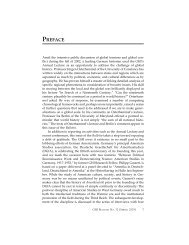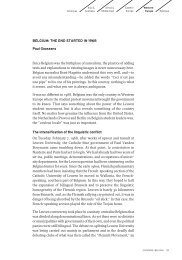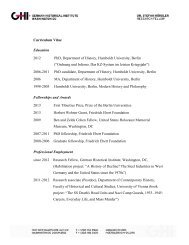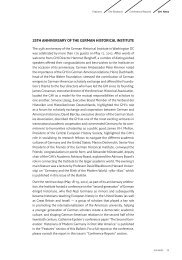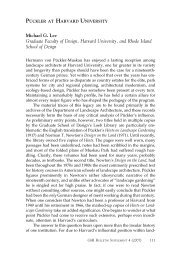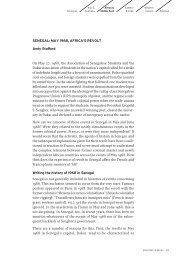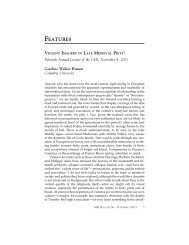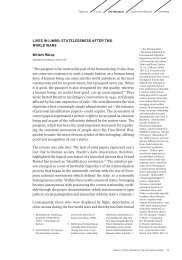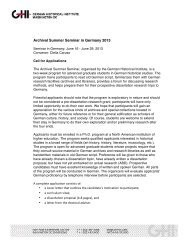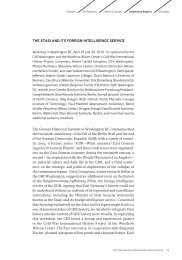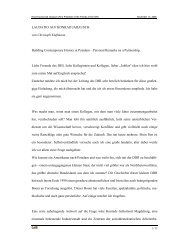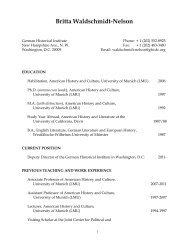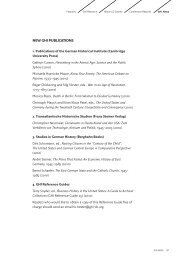German Student Exchange Programs in the United States, 1946-1952
German Student Exchange Programs in the United States, 1946-1952
German Student Exchange Programs in the United States, 1946-1952
You also want an ePaper? Increase the reach of your titles
YUMPU automatically turns print PDFs into web optimized ePapers that Google loves.
former Nazi leaders. 12 Individuals were not held responsible for crimes<br />
committed by <strong>the</strong>ir family members. As <strong>the</strong> exchange programs expanded,<br />
officials paid <strong>in</strong>creas<strong>in</strong>g attention to <strong>in</strong>dividual records ra<strong>the</strong>r<br />
than <strong>the</strong> simple question of membership <strong>in</strong> Nazi organizations. In some<br />
cases exchange participants had to go through as many as seven security<br />
checks to obta<strong>in</strong> a military exit permit and a visitor’s visa. 13<br />
While <strong>the</strong> program started out <strong>in</strong> <strong>the</strong> U.S. occupation zone, once <strong>the</strong><br />
Federal Republic of <strong>German</strong>y was founded persons from o<strong>the</strong>r parts of<br />
<strong>the</strong> country were allowed to apply as well. 14 By <strong>the</strong> comb<strong>in</strong>ed efforts of<br />
private and governmental organizations, about 3,000 <strong>German</strong> students<br />
visited <strong>the</strong> <strong>United</strong> <strong>States</strong> between <strong>1946</strong> and <strong>1952</strong>. 15 They were chosen on<br />
<strong>the</strong> basis of <strong>the</strong>ir knowledge of English as well as <strong>the</strong>ir declared will<strong>in</strong>gness<br />
to return to <strong>German</strong>y afterwards, and <strong>the</strong>y needed private sponsors<br />
<strong>in</strong> <strong>the</strong> <strong>United</strong> <strong>States</strong>. <strong>Student</strong>s were not <strong>the</strong> only group participat<strong>in</strong>g <strong>in</strong> <strong>the</strong><br />
exchange programs but <strong>the</strong>ir situation differed from that of o<strong>the</strong>rs.<br />
<strong>German</strong> Youth as an Investment <strong>in</strong> a Democratic Future<br />
<strong>Exchange</strong> programs generally targeted “leaders” and, <strong>in</strong> <strong>the</strong> case of<br />
young people, “future leaders.” The <strong>in</strong>clusion of young people was important.<br />
On <strong>the</strong> one hand, <strong>the</strong>y had to be at <strong>the</strong> center of a democratic<br />
renewal if changes <strong>in</strong> <strong>German</strong> society were to last. On <strong>the</strong> o<strong>the</strong>r hand,<br />
National Socialism had had a bigger impact on youth than on any o<strong>the</strong>r<br />
group. Unlike <strong>the</strong>ir parents or grandparents, young people were not able<br />
to fall back on social values that had been promoted before National<br />
Socialism. All <strong>the</strong>y knew was society as it had existed dur<strong>in</strong>g <strong>the</strong> twelve<br />
years of <strong>the</strong> Nazi regime. However, adolescence is a period of evaluation.<br />
Values, norms, styles of conduct are exam<strong>in</strong>ed, reflected upon, accepted<br />
and <strong>in</strong>ternalized—or discarded. Dur<strong>in</strong>g this time a young person develops<br />
a stand <strong>in</strong> favor of or aga<strong>in</strong>st a system and its representatives. Goals<br />
and methods to achieve <strong>the</strong>m are questioned. 16 <strong>German</strong> youth of <strong>the</strong><br />
postwar period needed alternative concepts of community and social<br />
behavior. This was recognized by occupation officials: “After <strong>the</strong> total<br />
bankruptcy of National Socialism, to which all young people were exposed<br />
<strong>in</strong> <strong>the</strong>ir formative years, <strong>the</strong>re rema<strong>in</strong>s very little to give <strong>the</strong>ir lives<br />
a new direction. They live <strong>in</strong> a society characterized by political, economic,<br />
and social disorganization, where democratic ideas have not taken<br />
sufficient root to give rise to a new growth of culture and education. The<br />
importation of new ideas and methods through exchange of books, magaz<strong>in</strong>es,<br />
educational films, etc., while of great value to a reeducation program,<br />
cannot alone accomplish <strong>the</strong> task. It is imperative, <strong>the</strong>refore, that a<br />
large number of young <strong>German</strong>s be brought face to face with a democratic<br />
way of life, with<strong>in</strong> <strong>the</strong> <strong>United</strong> <strong>States</strong> and o<strong>the</strong>r countries.” 17<br />
GHI BULLETIN NO. 30(SPRING 2002) 125




